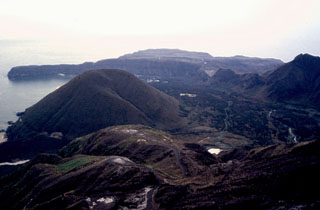Report on Kikai (Japan) — July 2001
Bulletin of the Global Volcanism Network, vol. 26, no. 7 (July 2001)
Managing Editor: Richard Wunderman.
Kikai (Japan) Ashfall and volcanic tremor through July 2001
Please cite this report as:
Global Volcanism Program, 2001. Report on Kikai (Japan) (Wunderman, R., ed.). Bulletin of the Global Volcanism Network, 26:7. Smithsonian Institution. https://doi.org/10.5479/si.GVP.BGVN200107-282060
Kikai
Japan
30.793°N, 130.305°E; summit elev. 704 m
All times are local (unless otherwise noted)
This report covers activity through July 2001. Volcanic tremor was recorded during 20 to 23 July 2001. A seismometer about 700 m SW of Iwo-dake crater recorded 50-110 earthquakes daily, in comparison to 30-90 earthquakes recorded daily during December 2000 and March 2001. The Iwo-jima branch of the Mishima village office reported that ash fell during 19-21 July. A white plume rose to ~ 20 m above the crater. Faint ashfall and weak volcanic tremor had occurred since December 2000.
Geological Summary. Multiple eruption centers have exhibited recent activity at Kikai, a mostly submerged, 19-km-wide caldera near the northern end of the Ryukyu Islands south of Kyushu. It was the source of one of the world's largest Holocene eruptions about 6,300 years ago when rhyolitic pyroclastic flows traveled across the sea for a total distance of 100 km to southern Kyushu, and ashfall reached the northern Japanese island of Hokkaido. The eruption devastated southern and central Kyushu, which remained uninhabited for several centuries. Post-caldera eruptions formed Iodake (or Iwo-dake) lava dome and Inamuradake scoria cone, as well as submarine lava domes. Recorded eruptions have occurred at or near Satsuma-Iojima (also known as Tokara-Iojima), a small 3 x 6 km island forming part of the NW caldera rim. Showa-Iojima lava dome (also known as Iojima-Shinto), a small island 2 km E of Satsuma-Iojima, was formed during submarine eruptions in 1934 and 1935. Mild-to-moderate explosive eruptions have occurred during the past few decades from Iodake, a rhyolitic lava dome at the eastern end of Satsuma-Iojima.
Information Contacts: Volcano Research Center, Earthquake Research Institute, University of Tokyo, Yayoi 1-1-1, Bunkyo-ku, Tokyo 113-0032, Japan (URL: http://www.eri.u-tokyo.ac.jp/VRC/index_E.html).

